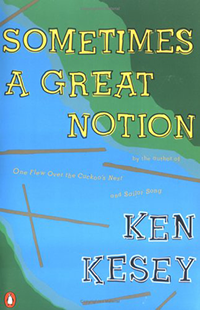Sometimes a Great Notion by Ken Kesey
- Andrew Imbrie Dayton
- May 1, 2013
This monthly feature invites readers to (re)discover a work that’s so rich and delightful it calls for slow reading to appreciate it fully.

“Along the western slopes of the Oregon Coastal Range … come look: the hysterical crashing of tributaries as they merge into the Wakonda Auga River.”
Opening with this evocative, faintly Homeric imperative (“Sing to me of the man, Muse, the man of twists and turns driven time and again off course …”*) Kesey’s iconic 60s novel immediately enthralls. No sooner are your toes in the water than you’re slipping down the metaphorical Wakonda Auga, which conceals “the cruel file-edge of its current beneath a smooth and calm-seeming surface,” all the way to a rough and woolly netherworld of hardboiled loggers and hapless tradesmen.
A century and a half of footloose, hardscrabble Stampers have beaten their way across the continent, finally staking a claim along the perpetually eroding banks of the Wakonda Auga River, where they are embroiled in a bitter fight with the union that protects their fellow townsmen. Leading the charge is hard-drinking, sore-knuckled, cork-booted scion Hank Stamper, every inch the son of aged father Henry, who still drives the family forward with his motto “Never give an inch.” Into this melee returns Hank’s estranged younger brother, the disaffected, intellectual, emotionally needy Leland, who seeks to exact revenge upon his overbearing older brother.
The setting for this tale is as rich and unforgettable as the story, a rainy world of moss and damp socks, cigarette butts and beer cans, bar fights and mangled limbs, stale pizza and slobbering hounds. Yet, amid the chaos and the grime there is a refuge of beauty and warmth, namely, Hank Stamper’s wife, Viv, who becomes the object of Leland’s desire. Largely because of Viv, it is the tough-as-nails logger who surprises with his sensitivity and the effete intellectual who surprises with his callousness. In the end, though, they will both discover who they are and what they need to do to honor it.
This is a challenging work to read. It’s long. It rambles. The point of view shifts constantly (as many as four times in as many lines) and with little warning. But these very characteristics, which in the hands of lesser talent would be pointless distractions, in the hands of Kesey make Sometimes a Great Notion a work to be savored. The raucous, picaresque, rough-and-tumble style befits the backwoodsy characters of the story as well as it does the 1960s America of its author, a cauldron of newly free love, unruly hair and even more unruly drug use.
Yes, at times it reads as if the author were stoked out on something unnamable from an organic chemistry text (almost surely he was), but that’s just part of the whole ’60s scene. If you take the time to give the book a close read, you will discover that the plot is compelling, the dilemmas engaging and the characters as exasperating and as endearing as any brought to the page by Faulkner or Russo. Whether you like the book is up to you: you’re either on the bus or you’re not. But it always seemed to me the ones on the bus had all the fun.
Andrew Imbrie Dayton is co-author of The House That War Minister Built (Octavio Books, September 2011) with his wife, Elahe Talieh Dayton, and is a contributing editor for The Washington Independent Review of Books.
I want this book:
Politics & Prose
OR
![]()